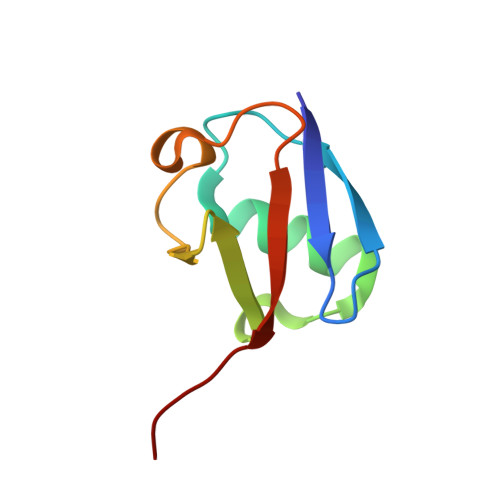NMR Characterization of Conformational Interconversions of Lys48-Linked Ubiquitin Chains.
Hiranyakorn, M., Yanaka, S., Satoh, T., Wilasri, T., Jityuti, B., Yagi-Utsumi, M., Kato, K.(2020) Int J Mol Sci 21
- PubMed: 32731397
- DOI: https://doi.org/10.3390/ijms21155351
- Primary Citation of Related Structures:
7CAP - PubMed Abstract:
Ubiquitin (Ub) molecules can be enzymatically connected through a specific isopeptide linkage, thereby mediating various cellular processes by binding to Ub-interacting proteins through their hydrophobic surfaces. The Lys48-linked Ub chains, which serve as tags for proteasomal degradation, undergo conformational interconversions between open and closed states, in which the hydrophobic surfaces are exposed and shielded, respectively. Here, we provide a quantitative view of such dynamic processes of Lys48-linked triUb and tetraUb in solution. The native and cyclic forms of Ub chains are prepared with isotope labeling by in vitro enzymatic reactions. Our comparative NMR analyses using monomeric Ub and cyclic diUb as reference molecules enabled the quantification of populations of the open and closed states for each Ub unit of the native Ub chains. The data indicate that the most distal Ub unit in the Ub chains is the most apt to expose its hydrophobic surface, suggesting its preferential involvement in interactions with the Ub-recognizing proteins. We also demonstrate that a mutational modification of the distal end of the Ub chain can remotely affect the solvent exposure of the hydrophobic surfaces of the other Ub units, suggesting that Ub chains could be unique design frameworks for the creation of allosterically controllable multidomain proteins.
Organizational Affiliation:
Department of Functional Molecular Science, School of Physical Science, The Graduate University for Advanced Studies (SOKENDAI), 5-1 Higashiyama, Myodaiji, Okazaki, Aichi 444-8787, Japan.















